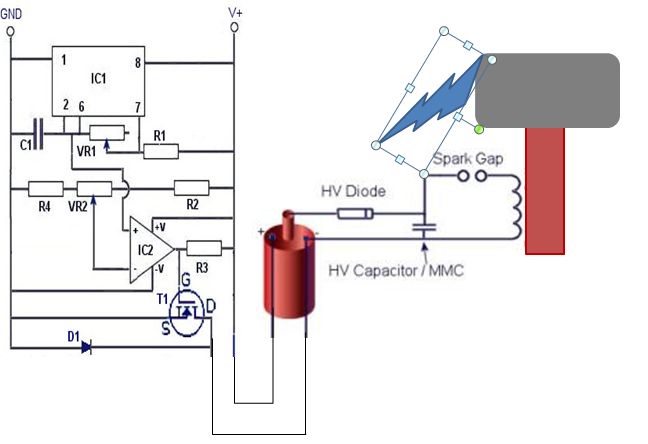
turret diy

For maximum mini-security, this RC Tupperware Turret delivers a formidable deterrent against food theft. While it lacks motion sensors, potential food thieves will think twice before attempting to swipe baked goods. This 11-hour project, designed by Chris of PyroElectro, emphasizes ease of replication. Chris encourages anyone interested in duplicating the project to consider how they might improve upon it. Utilizing servo motors, an IR receiver, and several additional components, this compact turret is controlled via a standard TV remote. Complete circuit layouts and a comprehensive parts list are provided to facilitate straightforward duplication. An accompanying video guides viewers through the process, and the code has already been prepared. Chris elevates the tutorial experience with his Tupperware Turret creation, which is based on a small electric Airsoft gun that fires plastic BBs, ensuring that any accidental hits on co-workers or family members will not cause harm, although it may provoke some irritation.
The RC Tupperware Turret project is an innovative approach to enhancing food security in a fun and engaging manner. The turret operates by integrating several key electronic components, including servo motors that provide the necessary movement and positioning capabilities. The IR receiver allows the turret to receive signals from a standard TV remote, enabling users to control the turret's actions from a distance.
The circuit design consists of a microcontroller that interfaces with the servo motors and the IR receiver, translating remote control commands into precise movements. The turret's base is constructed from Tupperware, providing a lightweight yet sturdy housing for the components. The use of an electric Airsoft gun mechanism allows for the turret to project small plastic BBs, serving as a harmless yet effective deterrent against would-be thieves.
For replication, the project documentation includes detailed circuit diagrams, ensuring that users can follow the schematic accurately. The parts list specifies all necessary components, including the model of the servo motors, the type of IR receiver, and any additional resistors or capacitors needed for circuit stability. The tutorial video serves as a visual guide, complementing the written instructions and allowing for a step-by-step assembly process.
Overall, the RC Tupperware Turret exemplifies a creative fusion of electronics and practical application, offering a unique solution to the common problem of food theft in communal settings.For maximum mini-security this RC Tupperware Turret packs a powerful punch. It may not have motion sensors, but food thieves will still think twice before swiping your baked goods. The 11-hour project, built by Chris of PyroElectro, was designed to be as easy as possible to replicate.
Chris even puts a call to action at the end of the tutorial [imploring] anyone wishing to duplicate this project to ponder over how they could do a better job. Using Servo Motors, an IR Receiver and a few other parts, this tiny turret is operated by a standard TV remote. All circuit layouts are given along with the list of parts needed to make duplication as easy as possible.
The above video takes you through the process so you can follow along with the tutorial and the code has already been written for you. Chris takes the art of tutorials to another level with his Tupperware Turret masterpiece. The turret itself is actually taken from a small electric Airsoft gun that shoots small plastic BBs. So if, by chance, you happen to hit a co-worker or family member, they will be unharmed. That still no guarantee they won`t be angry with you. 🔗 External reference
The RC Tupperware Turret project is an innovative approach to enhancing food security in a fun and engaging manner. The turret operates by integrating several key electronic components, including servo motors that provide the necessary movement and positioning capabilities. The IR receiver allows the turret to receive signals from a standard TV remote, enabling users to control the turret's actions from a distance.
The circuit design consists of a microcontroller that interfaces with the servo motors and the IR receiver, translating remote control commands into precise movements. The turret's base is constructed from Tupperware, providing a lightweight yet sturdy housing for the components. The use of an electric Airsoft gun mechanism allows for the turret to project small plastic BBs, serving as a harmless yet effective deterrent against would-be thieves.
For replication, the project documentation includes detailed circuit diagrams, ensuring that users can follow the schematic accurately. The parts list specifies all necessary components, including the model of the servo motors, the type of IR receiver, and any additional resistors or capacitors needed for circuit stability. The tutorial video serves as a visual guide, complementing the written instructions and allowing for a step-by-step assembly process.
Overall, the RC Tupperware Turret exemplifies a creative fusion of electronics and practical application, offering a unique solution to the common problem of food theft in communal settings.For maximum mini-security this RC Tupperware Turret packs a powerful punch. It may not have motion sensors, but food thieves will still think twice before swiping your baked goods. The 11-hour project, built by Chris of PyroElectro, was designed to be as easy as possible to replicate.
Chris even puts a call to action at the end of the tutorial [imploring] anyone wishing to duplicate this project to ponder over how they could do a better job. Using Servo Motors, an IR Receiver and a few other parts, this tiny turret is operated by a standard TV remote. All circuit layouts are given along with the list of parts needed to make duplication as easy as possible.
The above video takes you through the process so you can follow along with the tutorial and the code has already been written for you. Chris takes the art of tutorials to another level with his Tupperware Turret masterpiece. The turret itself is actually taken from a small electric Airsoft gun that shoots small plastic BBs. So if, by chance, you happen to hit a co-worker or family member, they will be unharmed. That still no guarantee they won`t be angry with you. 🔗 External reference





